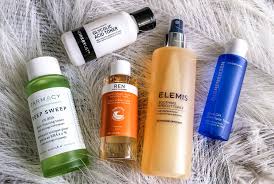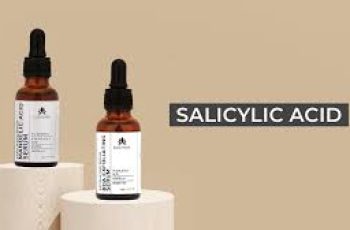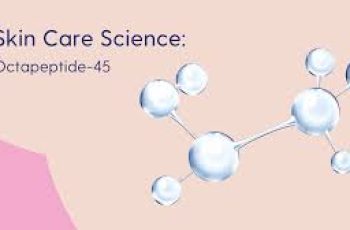Do You Need An Acid Toner For Your Face?
If you’ve been hanging around here for a while now, you may have a vague idea of what a toner and exfoliator is, so now you’re ready to know more about what an acid toner is and whether it is something you need to add to your skincare routine.
What is an acid toner?
Acid toners are a hybrid of exfoliators and regular toners, making them a pretty impressive product. The reason it has the name of acid toner is due to the fact they contain facial acids in the formulation to provide a chemical exfoliation to the skin when applied. Unlike physical exfoliation that requires you to manually work the scrub into the face to lift away any dirt, the build-up of dead skin cells and bacteria, chemical exfoliation is able to work on the outer layers of the skin to slough away any impurities that lead to a number of skin concerns without you lifting a finger. Check out our post about how chemical exfoliation works to perfect your skin to find out more on this.
Much like regular toners, acid toner will unclog the pores, remove dirt and debris and reveal a glowing complexion. The main difference is the ingredients in an acid toner work deep in the skin and reach areas other toners aren’t able to. The main advantage you will find is that acid toners are a lot more gentle on the skin in comparison to physical exfoliates which can drag the skin causing micro-tears, inflammation and fine lines.
What is the point of an acid toner?
During your skincare routine, a toner is applied after cleansing the skin. The original formula for toners was to help balance the skin’s pH level, which is normally slightly acidic at 5.5. Toners help to restore balance and prepare the skin for the rest of your routine and any products you apply after. Over the years there have been a number of toners that are more of a gimmick, these contain floral water designed to calm and soothe the skin after cleansing, though they may smell and feel divine on the skin, they don’t have much impact to your skin in regards to treating any concerns you may have, such as blackheads, uneven skin texture or a dull-looking complexion resulting in many of us deciding to not add to their skincare routine altogether. This is why acid toners have risen in popularity over the last few years making the toner step of your routine now as important as cleansing.
The main reason acid toners are giving such great results boils down to the acids blended into the mix, here are some keys ingredients to look for in an acid toner:
AHA
Glycolic acid
Citric acid
Latic acid
Mandelic acid
BHA
Salicylic acid
To find out more about these acids you can check out our post about the benefits of AHAs and BHAs for the skin.
Any toner containing any of these acids will give your skin a deep clean, unclogging the pores, hydrating the skin and reducing any pigmentation to the skin, a great deal more than regular toners. You may even discover that an acid toner was the missing step in your skincare regime you needed to help rejuvenate the complexion.
What are the benefits of using acid toner?
For a product that is so simple to use it is remarkable to think of the number of benefits you will find it has on the skin:
The benefits of using an acid toner
Smoother skin
Less acne
Glowing complexion
Increased collagen production
Improved skin health
Balanced pH
Promoted circulation
Decreased signs of ageing
The number of times you use an acid toner throughout the day is down to personal preference or how much your skin type will allow. Much like all skincare products, it is best to be mindful when introducing them to your routine. With the toner containing either an Alpha or Beta Hydroxy Acid over-using, it can become too harsh on the skin, stripping it of its natural oils which leads to a multitude of skin problems, especially in you have a dry or sensitive skin type.
Start by using the product once a day a couple of times a week and build from there, this will allow your skin time to become used to the effects the toner will have without shocking it. Once you have established the product works for you than you are able to use it as often as required. For more oily skin types using an acid toner in the morning and again in the evening will help keep on top of excess sebum and other impurities that can lead to breakouts and blemishes. For more dry or sensitive skin types use the acid toner in the evenings for a deep clean that won’t cause any irritation or reactions.
Are there any downsides to using an acid toner?
As previously mentioned if you find yourself being overzealous and using an acid toner too often you will find that over-exfoliating will lead to redness, irritation, increased dryness/flakiness, acne and increased oil production. If you are noticing some of these reactions its best to go back to basics and reduce how often you use the product.
You may also find your skin can feel a little thirsty after using an acid toner, especially if you don’t follow it with other products, like hydrating serums and moisturisers this will keep the skin looking healthy and glowing. It is also a good idea to stop using a physical exfoliating scrub whilst you use the toner to avoid any irritation from too much exfoliation.
Another thing to remember is that your skin will become more UV sensitive and so wearing a daily SPF of 30 or above is vital to keep your skin healthy and avoid any pigmentation or premature ageing caused by sun damage.
Do I really need an acid toner for my face?
We would certainly say yes, the beauty of acid toners is how simple they are to include in your routine. All you need to do is soak a disc of cotton, swipe it across the skin and leave the rest to the chemical exfoliating ingredient to put in all the hard work. Like all skincare products, it is really down to you and your preference whether you’d like to introduce it into your routine, but in all honesty, I don’t know anyone who wouldn’t appreciate a glowing, healthy, younger-looking skin.
Hopefully, this has helped you decide whether you need an acid toner for your face for not. For us, it is such a simple step to add into your routine to give you great results and one step closer to the flawless skin you’ve always dreamed of.
DQH Knowledge drop: In your 20s, your skin cell turnover decreases. (Cell turnover is a key component in keeping your skin youthful.) You know what else slows down? Your collagen production. Starting in your 20s, collagen decreases by about 1 percent per year. Should you want to prevent fine lines and wrinkles, start by eliminating behaviors that contribute to premature aging. “If it’s bad for you, it’s bad for your skin,” says dermatologist Michel Somenek.
“Cigarette smoking reduces blood flow to the skin and causes premature wrinkling and a dull skin texture. Making the repeated pursed motion to inhale can also cause smoker’s lines. Alcohol and recreational drugs are toxins for the skin that damage its cellular structure and DNA,” Somenek tells us. “The faster you eliminate vices while you are young, the better chance your skin and body have to recuperate.” Also, adopting an anti-aging routine in your 20s is key. After all, the best offense is a good defense. We spoke to Somenek and experts Joshua Ross and Audrey Kunin to find out more.
Keep reading for the best anti-aging products for your 20s, according to skincare professionals.
Sunscreen
“We all know that the sun is the number one cause of skin aging and starting the prevention in your 20s is very important,” Ross says. “The majority of your sun damage won’t start to appear until you’re in your 30s, so don’t wait until you see it surface or you’ll be behind the curve. Stay ahead of it with a good-quality zinc-based sunscreen worn daily.”
Farmacy Green Defense Daily Mineral Sunscreen
An invisible sunscreen with SPF 30, plus botanical extracts meant to protect skin with tons of antioxidants. Bonus: It’s clean and fine to use under makeup.
Bareminerals Complexion Rescue™ Tinted Moisturizer Broad Spectrum SPF 30
Although we recommend you use your SPF and moisturizer separately, we also understand moments when you don’t have time or energy for that extra step. For those times, this bareMinerals moisturizer is a great thing to have on hand.
Vitamin C Serum
“A great introduction to anti-aging is to start with a vitamin C serum in your morning skincare routine,” Ross says. “It’s a powerful antioxidant that will neutralize free radicals and brighten the skin.” He adds that it’s a great way to counteract the effects of the sun’s harmful rays, which, as previously mentioned, are among the biggest causes of premature aging.
Drunk Elephant C-Firma™ Vitamin C Day Serum
The Drunk Elephant C-Firma is a lightweight serum that promises to give skin a glow by combining the brightening powers of vitamin C with ferulic acid, l-ascorbic acid, and vitamin E. The included sodium hyaluronate is meant to replace hydration loss, so you shouldn’t have to deal with any irritation.
Sunday Riley C.E.O. Rapid Flash Brightening Serum
This potent serum is jam-packed with vitamin C (15 percent, to be exact), which means it’s a potential superstar at both brightening skin and dousing it in antioxidants.
Peptides
Using peptides on your skin has many benefits, says Somenek. “The skin barrier is what defends the body against pollution, UV rays, bacteria, and toxins. It can be damaged by several everyday factors. Using topical peptides aids in building a stronger barrier,” he says. “Peptides comprise elastic fibers, which are a type of protein. These fibers help to make skin appear taut and firm. Peptides can also help repair damaged skin, relieve inflammation, and even out skin tone. Some peptides can kill acne-causing bacteria that is common in 20-somethings.”
Kunin agrees, saying, “Peptides are an excellent entry point for supporting collagen.” She recommends looking for face and eye treatments that contain these collagen-boosting powerhouses.
Charlotte Tilbury Magic Eye Rescue Cream
This Charlotte Tilbury super-emollient eye cream has a base of coconut oil and shea butter (read: it’s incredibly hydrating). Botanicals plus peptides are meant to help reduce dark circles and boost collagen, respectively.
This creamy moisturizer serves up potent collagen-boosting peptides and pycnogenol, and antioxidant-rich vitamin C. “Instead of sitting on top of the skin, peptides penetrate the outer layer so they go deep. The ‘signals’ they send tell the cells to produce elastin and collagen, which are needed for youthful-looking skin,” explains Somenek.
At-Home Peel Pads
Remember that skin cell turnover fiasco we talked about earlier? One way to help support it is by exfoliating. “Exfoliation is important to help keep skin fresh and luminous,” Kunin says. She recommends using at-home peel pads as an easy and effective way to exfoliate.
“The goal in your 20s is to fight the slowing pace of cell turnover. It is wise to use products that gently exfoliate, yet still remove oil and other impurities. Products that have Alpha Hydroxy Acids (AHA) or Beta Hydroxy Acids (BHA) are a good choice.”
According to Somenek, you should only exfoliate two to three times a week. “People of all ages are guilty of over-exfoliating and that can be too much of a good thing,” he says.
Dermadoctor Kakadu C Intensive Vitamin C Peel Pad
A few swipes of this Derma Doctor powerful peel pad promise to leave your skin glowing and smooth, thanks to the seven (yes, seven) types of chemical exfoliants, including AHA and BHA. It also contains vitamin C via Kakadu plum extract for added brightening and antioxidant protection.
KEY INGREDIENTS Kakadu plum extract is sourced from the Kakadu plum, a fruit grown in northern Australia. It contains vitamin C, which restores the skin’s natural barrier, increases collagen production, and soothes irritation.
Dr. Dennis Gross Skincare Alpha Beta® Universal Daily Peel Pads
These are the gold standard of peel pads, with a cult following and over 900 five-star reviews on Sephora. They’re easy to use and contain a blend of anti-aging exfoliating acids.
Emollient Night Cream
“In your 20s, you need to start upping the hydration in your skincare routine. You may have been cautious of over-moisturizing because of acne in your teens, but as you enter your 20s, your skin transitions and becomes drier,” Ross says. “I recommend an emollient night cream added into your evening skincare regimen.”
“Twenty-somethings need to make sure that they are not using creams that will clog their pores and cause excess oil production,” says Somenek. Opt for non-comedogenic products.
Cerave Skin Renewing Night Cream
One great choice is the CeraVe Skin Renewing Night Cream, which is a non-comedogenic night cream that leaves skin soft and glowy. It combines the moisturizing powers of ceramides and hyaluronic acid.
RoC Retinol Correxion Max Hydration Creme
“The best night cream ingredients contain retinol, benzoyl peroxide, and/or salicylic acid or hyaluronic acid. The goal is to moisturize, yet remove excess oil,” says Somenek. This Roc Retinol Correxion cream fits the bill as it contains both hyaluronic acid and retinol so it promises to moisturize while also being non-comedogenic.



